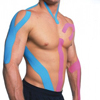 During the Olympics, you may have noticed brightly colored kinesiology (aka Kinesin) tape attached to the legs, backs, arms and other body parts of athletes.
During the Olympics, you may have noticed brightly colored kinesiology (aka Kinesin) tape attached to the legs, backs, arms and other body parts of athletes.
It’s meant to help stabilize tendons and joints and provide pressure relief. Researchers at the National Defense Academy, in Japan, studied its potential to alleviate muscle weakness.
First, the details.
- The study examined the effect of tactile stimulation in the form of kinesiology tape on muscle weakness secondary to attenuated nerve feedback.
- This weakness is neurophysiologically similar to that seen with knee injury.
- Theoretically, increasing input to gamma motor neurons (impulses from the CNS to the periphery) might reverse this weakness.
- Participants received both treatments in random order.
- Kinesiology tape was applied around each subject’s knee during maximal voluntary contraction measured after vibration.
- Non-taping condition: Tape was not applied prior to vibration.
- Average percentage changes between pre- and post-vibration were compared with and without tape.
And, the results.
- Maximal voluntary contraction and average electromyography measurement (electrical activity produced by skeletal muscles) were significantly larger with tape vs without tape.
The bottom line?
The authors concluded, “(The) results suggest that tactile stimulation in the form of kinesiology tape inhibits the decline of both strength and electromyography.
The number of participants wasn’t stated in the abstract.
There are few other studies to support using kinesiology tape.
- Hand muscle strength in 20 patients with rheumatoid arthritis increased significantly with kinesiology tape + physiotherapy vs physiotherapy alone.
- University of Technology, in Opole, Poland
- In 31 children with cerebral palsy, there was no direct effect of kinesiology tape on gross motor function and functional independence.
- However, sitting posture (head, neck, foot position and arm, hand function) was affected positively.
- Abant Izzet Baysal University School of Physical Therapy and Rehabilitation, in Bolu, Turkey
- In 41 patients with unilateral breast-cancer-related lymph edema for at least 3 months, kinesiology tape was acceptable to the patients.
- However, it didn’t affect the signs and symptoms of the condition.
- National Taiwan University, in Taipei
8/11/12 15:03 JR